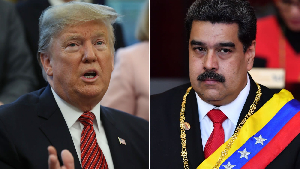"We have met the enemy and he is us," Pogo
The December, 2007 presidential elections troubles in Kenya that saw over 1,000 people killed reveals the unresolved “rage” of Africa’s ethnicity, as the Polish-born novelist Joseph Conrad will tell you in his famous “suppressed rage” phrase that fits some of Africa’s deadly ethnic conflicts. Despite attracting charges of racism and paternalism in the “Heart of Darkness,” Conrad’s observation of Africa mired in something primal and savage may be as relevant as practicable in certain ways as some African ethnic conflicts and bad governments show.
Some of the ethnic conflicts and some of the bad governments tell Africans that the central issue of genuine consolidation of their nation-states isn’t well formed and that it isn’t whether the African nation-states weren’t created by Africans or in the ensuing creation by the Europeans some ethnic groups are thought to be incompatible as some Nigerians will tell you of some of the 250 ethnic groups that form their country. The key challenge is how African elites can work with their European creation in such a way that they are able to appropriate the various ethnic groups’ histories and traditional values that form their nation-states for peace and progress. For scholarship and research, as Daniel Tetteh Osabu-Kle makes clear in “Compatible Cultural Democracy: The Key to Development in Africa,” part of the solutions of resolving some of the perennial African ethnic tensions and conflicts lies in “using modified, indigenous political structures and ideologies.”
In Ghana, the Konkomba and the Bimoba, among some few groups, have been having on-again, off-again bloody conflicts. Still, in Ghana the Ewe ethnic group, some of which groups have suffered some bloody chieftaincy conflicts recently, feel hated within the nation-state and one of their traditional rulers, Agbogbomefia of the Asogli, Togbe Afede XIV, has observed that only the ideals of good governance can cure long simmering tribalism and ethnicity. In eastern Democratic Republic of the Congo (DRC), the story is as fearful and bloody today as Conrad’s 1902 “Heart of Darkness,” which was set in the DRC.
In Central African Republic, the ethnic conflict is so bad that it appears it has become a "forgotten emergency," the country suffering from “more than a decade of political instability.” In Chad, in mixture of ethnic conflicts, family feud and oil windfall over 100 people have been killed in the past weeks. In Nigeria, Africa’s most populous country with 250 ethnic groups and over 800 dialects, ethnic conflicts in some of the regions have become a daily diet and some Nigerians think their country is ungovernable. With nearly two million displaced people living in squalid camps and thousand killed, Sudan’s ethnic conflict ridden Darfur region is as true as Conrad’s character.
Once again, Kenya’s election-influence ethnic conflict reveals the weak foundation of the African nation-state. Despite its pretensions, as Robert Calderisi, author of “The Trouble With Africa: Why Foreign Aid isn’t Working,” recalls, from start, Kenya, if its troubles are viewed from the bigger picture, hasn’t been as cool as the uninformed thinks - its foundational ethnic structures weak. In the 1950s, in the land war among the Kikuyu ethnic group called the Mau Mau Rebellion, some 50,000 people were killed. In an assassination that traumatized Africa, Tom Mboya, a rising politician of his age group was killed. For fear of ethnic conflict, Nairobi, the Kenyan capital, was virtually shut down for three days when President Jomo Kenyatta died in 1978.
Still, to avoid ethnic conflict between the Kikuyu, who have ruled Kenya since independence in 1963, and the Luo, their main rival, as Calderisi argues, the ruling party, KANU (Kenya African National Union), chose an interim leader from a small group, the Kalenjin, Daniel Arap Moi, who ruled for 24 years. In a pattern where watchers argue reveal Kenyan leaders brewing ethnic conflicts during election periods to suit their political whims and caprices, in 1992 and 1997, in the western Rift Valley and along the coast, bloody conflicts were common feature, disrupting one of Kenya’s sources of income, tourism.
The Kenyan ethnic conflict also shows that for the past 50 years Africans have suffered from bad leaders who either have weak grasp of the traditional values wheeling their nation-states or do not understand their nation-states, from within their foundational traditional values, or do not care about their people’s peace despite their long-suffering and fatalism. But how durable is African peoples’ peace? Calderisi argues that in the 1990s as some of Africa’s states such as Sierra Leone, Liberia, Somalia and Zaire (DRC) smoulder, “eight in ten Africans were still living in peace. But it was false peace.”
Africans’ false peace emanates from the fact that their traditional values do not technically drive their nation-states’ progress but rather their ex-colonial ones, and in the ensuing confusion, creating false development processes among the over 2,000 ethnic groups with their over 3,000 dialects that form Africa – and creating all sorts of conflicts, some of which tension dates back to pre-colonial times, with the slightest mishap as the recurring ethnic conflicts in some parts of northern Ghana show. The false peace and deadly conflicts also show an Africa which two solitudes – the traditional and the ex-colonial neo-liberal/Western – not reconciled enough to harmonize the two Africas for peace and progress, as George B. N. Ayittey argues in “Africa in Chaos.”
In most of the 1980s, and good part of the 1990s, as African nation-states face severe crises and appear to be crumbling because of the rupture between ex-colonial legacies and African indigenous values, the London, UK-based African Confidential newsletter (January 6, 1995) explained that “There are signs everywhere that the era of the nation-state is fading and nowhere is this clearer than in Africa, where its roots are shallowest. The awkward marriage of the ‘nation’ in the sense of an ethnic coalition and the ‘state’ as the principal source of political authority is coming under pressure from above and below.” The fact is, the roots of African nation-state are not shallow, for it stands firmly in African traditional values. What is shallowest is the “state,” as ex-colonial creation, not skillfully and properly weaved into the “nation” as a development project.
How incompatible is the African state and the African nation, structurally and developmentally, is captured in Joshua B. Forrest’s investigative work “Subnationalism in Africa: Ethnicity, Alliances, and Politics.” Forest makes the case that the emergence of Africa’s subnationalism movements today, despite the near-commonality of African cultures, aim to rally political power as a way of seeking territorial autonomy within a particular nation-state because of either power issues as is seen in Kenya or natural resource problems as was seen in Sierra Leone or developmental inadequacies as Sudan show.
In a way, as Jeffrey Herbst analyses in “States and Power in Africa: Comparative Lessons in Authority and Control,” the problem of state consolidation from the pre-colonial phase, through the short but intense interlude of European colonialism, to the modern era of independent states, is riddled with misunderstanding and many unresolved issues by African elites. As Kenya, Sudan’s Darfur, Central African Republic, the Niger Delta of Nigeria, eastern Democratic Republic of the Congo, among others, show, Herbst's makes bold analytical case that the conditions now facing African state-builders is to work to resolve what had existed long before the European colonialists came to Africa.
While former United Nations chief Kofi Annan, the African Union and the international community may work to douse off the Kenya election-fueled ethnic conflicts, the underlying challenge is how to stem off the country’s self-destruction in the long haul. That may involve not only Annan and the international community, which work will soon end, but the appropriation of Kenyan/African traditional values and institutions, as George Ayittey argues in “Indigenous African Institutions,” into resolving the long-running tensions and conflicts that pre-dates Kenya that will make the over 70 distinct ethnic groups that form the Kenyan nation-state feel good.
The idea isn’t only to avoid “ethnic rage” disguised under false peace but also as Pogo, the Walt Disney cartoon character, says, "We have met the enemy and he is us" – that’s the understanding that Africa’s troubles, as George Ayittey explains in “Africa Betrayed,” should start from its elites’ bad behaviour and their inability to understand the continent from within its traditional institutions and values. And that makes the African’s so-called enemy himself/herself first and any other second. The hard reality is that either in the Kenyan elections or the Togolese elections in 2005 that saw over 800 people killed, as Thomas Spears argues in “Neo-Traditionalism and the Limits of Invention in British Colonial Africa,” Africa’s ethnic conflict has much to do with Africans’ pre-colonial conditions as much as its colonial and post-colonial circumstances. .















